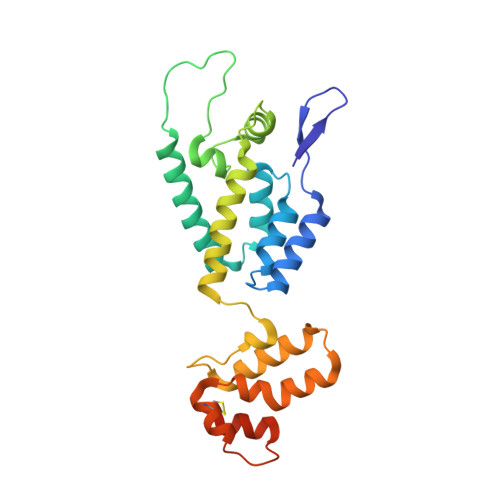Structure and Dynamics of Full-Length HIV-1 Capsid Protein in Solution.
Deshmukh, L., Schwieters, C.D., Grishaev, A., Ghirlando, R., Baber, J.L., Clore, G.M.(2013) J Am Chem Soc 135: 16133-16147
- PubMed: 24066695
- DOI: https://doi.org/10.1021/ja406246z
- Primary Citation of Related Structures:
2M8L, 2M8N, 2M8P - PubMed Abstract:
The HIV-1 capsid protein plays a crucial role in viral infectivity, assembling into a cone that encloses the viral RNA. In the mature virion, the N-terminal domain of the capsid protein forms hexameric and pentameric rings, while C-terminal domain homodimers connect adjacent N-terminal domain rings to one another. Structures of disulfide-linked hexamer and pentamer assemblies, as well as structures of the isolated domains, have been solved previously. The dimer configuration in C-terminal domain constructs differs in solution (residues 144-231) and crystal (residues 146-231) structures by ∼30°, and it has been postulated that the former connects the hexamers while the latter links pentamers to hexamers. Here we study the structure and dynamics of full-length capsid protein in solution, comprising a mixture of monomeric and dimeric forms in dynamic equilibrium, using ensemble simulated annealing driven by experimental NMR residual dipolar couplings and X-ray scattering data. The complexity of the system necessitated the development of a novel computational framework that should be generally applicable to many other challenging systems that currently escape structural characterization by standard application of mainstream techniques of structural biology. We show that the orientation of the C-terminal domains in dimeric full-length capsid and isolated C-terminal domain constructs is the same in solution, and we obtain a quantitative description of the conformational space sampled by the N-terminal domain relative to the C-terminal domain on the nano- to millisecond time scale. The positional distribution of the N-terminal domain relative to the C-terminal domain is large and modulated by the oligomerization state of the C-terminal domain. We also show that a model of the hexamer/pentamer assembly can be readily generated with a single configuration of the C-terminal domain dimer, and that capsid assembly likely proceeds via conformational selection of sparsely populated configurations of the N-terminal domain within the capsid protein dimer.
Organizational Affiliation:
Laboratory of Chemical Physics and ‡Laboratory of Molecular Biology, National Institute of Diabetes and Digestive and Kidney Diseases, National Institutes of Health , Bethesda, Maryland 20892-0520, United States.














